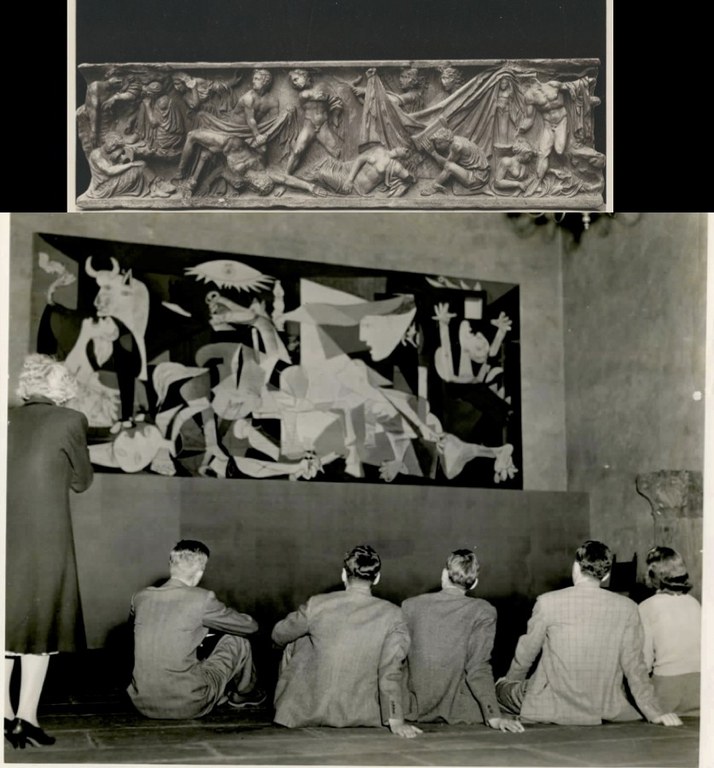Vortrag // Francisco Prado Vilar: Picasso’s Nachleben: Tragedy, Exile, and the Visual Archaeology of Guernica
Termindetails
Wann
von 18:15 bis 20:00
Wo
During the spring of 1937, as Picasso worked tirelessly on Guernica at his Parisian studio, conjuring up images of despair, destruction and fratricidal violence to capture the tragedy of the Spanish Civil War, the basement of the National Archaeological Museum in Madrid had become a bunker where many of the artworks he had long admired were being stored away to keep them safe from the bombings. Among them was a Roman sarcophagus decorated with a Greek family tragedy, which unfolds on an elongated frieze in a sudden explosion of violence rippling out in chiastic movements. In the center is Orestes who, having just slayed his mother Clitemnestra and her lover to avenge the assassination of his father Agamennon, begins to ponder the consequences of his atrocious crime. This lecture explores the active presence of the imagery of this sarcophagus in the context of the Spanish Civil War, and in the lives of those involved in the making of Guernica. It follows a trail of photographs and letters leading from the basement of the National Archaeological Museum in Madrid to the Warburg Hall of the Fogg Museum at Harvard where, in 1941, Guernica made a stop in its pilgrimage in exile. There, Picasso’s canvas was unrolled, mounted on Romanesque capitals, and exhibited in the company of other Spanish “exiles” in an installation that poignantly captured its tragic genealogy, and activated its power as a witness to history, and as a nexus linking history (and the present) to the time of myth.

Francisco Prado-Vilar is Distinguished Researcher at the University of Santiago de Compostela. He received his PhD from Harvard University and subsequently held teaching and research positions at Princeton, University of London (Birkbeck), Complutense University in Madrid, and Stanford. Before joining the University of Santiago, he was Director of Projects at the Royal Complutense College at Harvard, where he is now a senior research associate. For the past few years, he has been involved in several projects focusing on the study and preservation of cultural heritage, serving as member of the panel of the European Heritage Label, and as coordinator of the scientific committee overseeing the restoration of the Portal of Glory of Santiago Cathedral, where he led a multidisciplinary team of art historians, architects, and conservation scientist funded by the Mellon Foundation.
His research and publications focus on diverse aspects of the arts of medieval and early Modern Europe, covering topics of wide chronological, thematic, and methodological range, including the afterlife of Antiquity from the early Middle Ages to the Renaissance; Romanesque and Gothic monumental programs; intercultural relations among Christians, Muslims, and Jews in the Gothic period; the interface of private suffering, devotional painting, and national trauma in Hispano-Flemish painting; the interconnections between medievalism and modernity; the theory and practice of photography in art history; and the archaeology of archives. Among his most recent publications are the two edited volumes produced within the framework of Santiago Cathedral project: “The Portal of Glory: Architecture, Matter and Vision” (2020) and “The Portal of Glory: Conservation, Polychromy, and the Transfiguration of Matter”(2021) available in Open Access. Other recent publications are: “The Marble Tempest: Material Imagination, the Echoes of Nostos, and the Transfiguration of Myth in Romanesque Sculpture,” in Icons of Sound: Voice, Architecture and Imagination in Medieval Art, ed. Bissera V. Pentcheva (New York: Routledge, 2020), “The Superstes: Resurrection, the Survival of Antiquity, and the Poetics of the Body in Romanesque Sculpture,” in Transformatio et Continuatio – Forms of Change and Constancy of Antiquity in the Iberian Peninsula 500-1500, ed. H. Bredekamp and S. Trinks (Berlin and Boston: De Gruyter, 2017), “The Awakening of Endymion: Beauty, Time, and Eternity in Romanesque Sculpture and Its Photographic Afterlife,” Codex Aquilarensis 35, Special issue: Beauty, Persuasion and Rhetoric in Medieval Art (2019), pp. 223- 51
[Image credit: Arthur Kingsley Porter photograph, courtesy of Special Collections, Fine Arts Library, Harvard. UniversityHarvard Art Museums Archives. Photo: Imaging Department © President and Fellows of Harvard College]
___________
PARTICIPATION:
The talk will take place in a hybrid format. You can either attend in-person or virtually via Zoom. You can join the Zoom meeting at the following link: https://us02web.zoom.us/j/85659345839?pwd=UmFZYU0xN1NxMGJ1MjlQM054NXgvZz09. Meeting-ID: 856 5934 5839 | Passwort: 148258.
